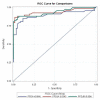Early Detection of Mycobacterium avium subsp. paratuberculosis Infected Cattle: Use of Experimental Johnins and Innovative Interferon-Gamma Test Interpretative Criteria
- PMID: 34055946
- PMCID: PMC8160102
- DOI: 10.3389/fvets.2021.638890
Early Detection of Mycobacterium avium subsp. paratuberculosis Infected Cattle: Use of Experimental Johnins and Innovative Interferon-Gamma Test Interpretative Criteria
Abstract
Paratuberculosis (PTB), also known as Johne's disease, is a chronic proliferative enteritis of ruminants caused by Mycobacterium avium subsp.paratuberculosis (MAP). To date, PTB diagnosis, based on serology, fecal culture, and real-time polymerase chain reaction, has identified animals in advanced stages of infection. To detect MAP infection in animals earlier, the interferon-gamma (IFN-γ) test may be applied. This assay detects cytokines produced by T-lymphocytes of infected subjects after stimulation with purified protein derivatives (PPDs), extracted from Mycobacterium bovis (MB) and from M. avium (MA). The study involved three bovine herds: one PTB-infected herd, one PTB-free herd, and one with an outbreak of bovine tuberculosis. The IFN-γ test was performed on 235 animals, using bovine PPD (PPDB), avian PPD (PPDA), and three experimental PPD Johnins (PPDJs) extracted from a synthetic liquid medium culture of MAP (PPDJ A, B, and C), to assess early MAP detection and avoid false reactions to MB. Furthermore, IFN-γ results were evaluated using 12 interpretative criteria (ICs), based on the differences and ratio between PPD optical density (OD) and IFN-γ basal OD values after lymphocytic stimulation. IC accuracy was expressed as area under the receiver operating characteristic curve. Through a longitudinal study, PPDJs proved to be specific and sensitive in the detection of MAP-infected animals. Among the evaluated ICs, six showed the best performance in terms of accuracy (p < 0.0001), highlighting PTB subclinical infections. In particular, the two best criteria reached sensitivity values of 100% [confidence interval (CI) 95%, 94.1-100%] with a specificity of 91.8% (CI 95%, 81.9-97.3%) and sensitivity levels of 80.6% (CI 95%, 69.1-89.2%) with a specificity of 100% (CI 95%, 94.1-100%). Thus, the IFN-γ assay proved to be a useful diagnostic tool to identify early subclinical MAP-infected animals, in order to manage infected cattle or those exposed to MAP and to monitor younger calves within a herd. Furthermore, the IFN-γ test can be considered an additional test to avoid the introduction of MAP-infected animals, especially in herds where disease has already been eradicated and preservation of the health status is required to maintain the PTB certification level.
Keywords: IFN-γ test; Johne's disease; Johnin PPD; Mycobacterium avium subsp. paratuberculosis; bovine paratuberculosis; cattle; interpretative criteria; purified protein derivatives.
Copyright © 2021 Corneli, Di Paolo, Vitale, Torricelli, Petrucci, Sebastiani, Ciullo, Curcio, Biagetti, Papa, Costarelli, Cagiola, Dondo and Mazzone.
Conflict of interest statement
The authors declare that the research was conducted in the absence of any commercial or financial relationships that could be construed as a potential conflict of interest.
Figures



Similar articles
-
Field performance of six Mycobacterium avium subsp. paratuberculosis antigens in a 20h interferon gamma release assay in Belgium.Vet Immunol Immunopathol. 2017 Jul;189:17-27. doi: 10.1016/j.vetimm.2017.05.008. Epub 2017 May 30. Vet Immunol Immunopathol. 2017. PMID: 28669383
-
Evaluation of mycobacteria-specific gamma interferon and antibody responses before and after a single intradermal skin test in cattle naturally exposed to M. avium subsp. paratuberculosis and experimentally infected with M. bovis.Vet Immunol Immunopathol. 2018 Feb;196:35-47. doi: 10.1016/j.vetimm.2017.12.007. Epub 2017 Dec 12. Vet Immunol Immunopathol. 2018. PMID: 29695323
-
Interferon-γ Response of Mycobacterium avium subsp. paratuberculosis Infected Goats to Recombinant and Synthetic Mycobacterial Antigens.Front Vet Sci. 2021 Mar 26;8:645251. doi: 10.3389/fvets.2021.645251. eCollection 2021. Front Vet Sci. 2021. PMID: 33842578 Free PMC article.
-
A scoping review on associations between paratuberculosis and productivity in cattle.Front Vet Sci. 2024 May 2;11:1352623. doi: 10.3389/fvets.2024.1352623. eCollection 2024. Front Vet Sci. 2024. PMID: 38756521 Free PMC article.
-
Lateral-flow assays for bovine paratuberculosis diagnosis.Front Vet Sci. 2023 Oct 12;10:1257488. doi: 10.3389/fvets.2023.1257488. eCollection 2023. Front Vet Sci. 2023. PMID: 37901111 Free PMC article. Review.
Cited by
-
Detection of Low MAP Shedder Prevalence in Large Free-Stall Dairy Herds by Repeated Testing of Environmental Samples and Pooled Milk Samples.Animals (Basel). 2022 May 25;12(11):1343. doi: 10.3390/ani12111343. Animals (Basel). 2022. PMID: 35681807 Free PMC article.
-
Clinical insights on paratuberculosis in Arabian camels (Camelus dromedarius): A review.Open Vet J. 2025 Jan;15(1):8-17. doi: 10.5455/OVJ.2025.v15.i1.2. Epub 2025 Jan 31. Open Vet J. 2025. PMID: 40092173 Free PMC article. Review.
-
Development and Validation of a Novel ELISA for the Specific Detection of Antibodies against Mycobacterium avium Subspecies paratuberculosis Based on a Chimeric Polyprotein.Vet Med Int. 2021 Dec 29;2021:7336848. doi: 10.1155/2021/7336848. eCollection 2021. Vet Med Int. 2021. PMID: 35003619 Free PMC article.
-
Evaluation of Single Nucleotide Polymorphisms (SNPs) Associated with Genetic Resistance to Bovine Paratuberculosis in Marchigiana Beef Cattle, an Italian Native Breed.Animals (Basel). 2023 Feb 7;13(4):587. doi: 10.3390/ani13040587. Animals (Basel). 2023. PMID: 36830374 Free PMC article.
-
Pathological, microscopic, and molecular diagnosis of paratuberculosis/John's disease in naturally infected dromedary camel (Camelus dromedarius).Vet World. 2023 Jun;16(6):1277-1283. doi: 10.14202/vetworld.2023.1277-1283. Epub 2023 Jun 8. Vet World. 2023. PMID: 37577185 Free PMC article.
References
-
- Chiodini RJ, Van Kruiningen HJ, Merkal RS. Ruminant paratuberculosis (Johne's disease): the current status and future prospects. Cornell Vet. (1984) 74:218–62. - PubMed
LinkOut - more resources
Full Text Sources
Other Literature Sources
Molecular Biology Databases
Miscellaneous

